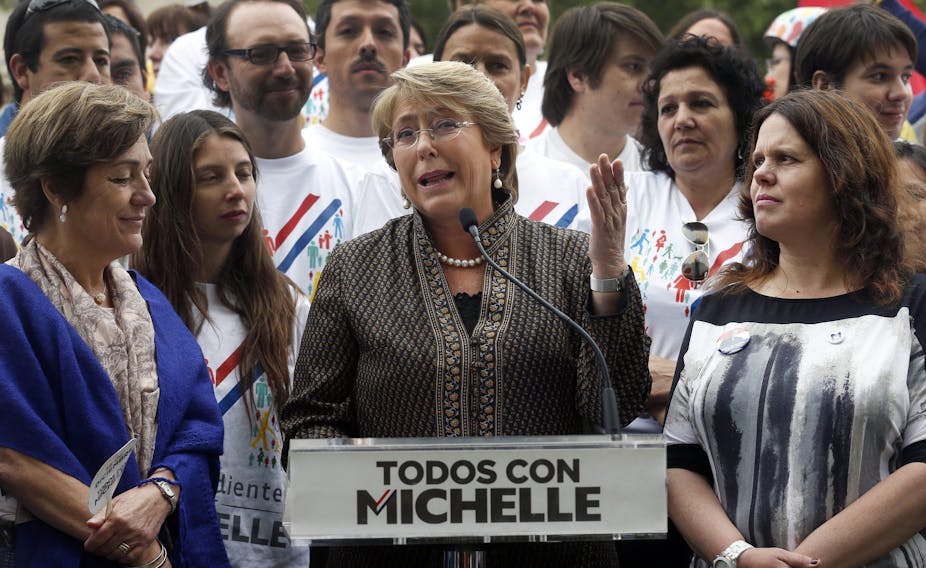It’s a case of back to the future in Chile after voters returned former president Michelle Bachelet to that position at the weekend. In a country that doesn’t allow the president to serve two consecutive terms, it seems the electorate’s trust in Bachelet – who registered an incredible 84% approval rating when she left office in March 2010 – continues unabated.
After winning the first round of voting on November 17 with 47% of the vote and a majority in both the Senate and the Chamber of Deputies (lower house) of the Congress, Bachelet won the run-off election against right-wing candidate Evelyn Matthei with around 62% of the vote.
This was an important election for one of Latin America’s most prosperous and developed nations. Nevertheless, Chile has deplorable levels of social inequality, particularly in education, health services, tax, recognition of Indigenous nations and treatment of Indigenous peoples. All of these issues will be on Bachelet’s agenda as she prepares to take office again.
Both female candidates represent the two traditional political blocs in Chile. Both are daughters of air force generals: one a member of the military junta that ruled Chile for 17 years (Matthei), while Bachelet’s father was accused of treason, tortured and allegedly murdered by the dictatorship.
Bachelet, a paediatrician by training, served as the first female President of Chile from 2006 to 2010. She went on to head the newly created UN Women from 2011 to 2013.
As president-elect, Bachelet heads a new coalition – Nueva Mayoría (New Majority) – made up of old social democrat and new progressive political actors. The coalition crosses a broad spectrum of social and political forces from the Communist Party on the left to the Christian Democratic Party in the centre. It is a mixture of the same old faces and new faces, as Bachelet recently described it.
The rise of youth
However, the outcome of the election indicates the expectations for profound changes in Chile. To a large extent, this is because of the student movement that rocked the country to its core in 2011.
It was the student movement and the social movements at large that fundamentally set the agenda of radical transformation of Chile’s education sector, tax reform and the drafting of a new Constitution. The current one was passed in 1980 during Pinochet’s dictatorship.
Four leading figures of the 2011 Student Movement – all under 30 years old – have been elected to the Lower House, and all with over 40% of first preference votes. The charismatic Camila Vallejo – described by The Guardian in 2011 as “Latin America’s 23-year-old new "revolutionary folk hero”, won a seat for the Communist Party.
Vallejo will be joined by other “children of neoliberalism” and fellow street protest leaders Karol Cariola (Communist Party), Giorgio Jackson (Radical Democracy) and Gabriel Boric (Autonomous Left).
All have vowed to dismantle the system from the inside. In response, many conservative commentators in Chile and around the world are asking if this might be the end of the Chilean economic miracle.
What’s at stake
Education reform has been a cornerstone of the changes envisioned by the newly elected “youth bench”.
Chile is the most expensive country in the world for local students. According to an OECD study, in Chile around 75% of education costs are met through private expenditure. By way of comparison, this level is around 40% in Australia and the US, and as low as 5% in Scandinavia.
The three fundamental and inextricably linked reforms in Bachelet’s program of government (and which includes US$15.1 billion in public spending), are education reform to provide free university education within six years – a policy that has raised eyebrows, even in Australia; tax reform (restructuring the entire tax system and raising corporate tax to 25%); and constitutional reform.
The last of these reforms may involve a referendum to establish a constitutional assembly to draft the new constitution, or a more moderate process through Congress.

New challenges
Bachelet’s return to the presidency will be under very different circumstances to her first stint in office. Then, her government was marked by the exhaustion of the Concertación coalition that had ruled the country since 1990, the global financial crisis, and civil unrest, marked by massive student mobilisations.
Without any doubt Bachelet will face new challenges and complexities. At the November election, 10% of voters responded to the citizen-driven initiative to stamp their ballots with “AC” (Constitutional Assembly), calling for a participatory mechanism to reform the constitution. She will need to manage the expectations of a citizenry that is demanding profound changes in social equality and those pursuing a more participatory democracy.
Chile is also in urgent need of reform in its environmental policy and energy and resources sector. It imports two-thirds of its energy needs and 97% of its oil and natural gas. Although over two-thirds of its electricity is generated by thermoelectric plants, the remaining third comes from hydroelectric power.
Chile was the cradle of Milton Friedman’s neoliberal reforms in the 1980s and in 2010 – during the last days of Bachelet’s first term – became the OECD’s 31st member and the first in South America. But now it is a country where a new majority is showing genuine aspirations for a more equitable and participatory model of democracy.
The question remains whether Bachelet’s return is a case of “turn left and proceed with caution”, or whether Chile must brace itself for an exciting yet turbulent period.

